To set durable bamboo fence posts, dig holes 18-24 inches deep, with a diameter three times the post width. Add 2-3 inches of gravel for drainage before inserting posts. Use pressure-treated lumber or galvanized steel for support posts and secure bamboo with marine-grade fasteners. Apply high-quality waterproof sealant and anti-fungal treatment to extend lifespan from 2 years to 15-20 years. With proper installation and maintenance, your bamboo fence will stand strong through changing seasons.
Selecting the Ideal Bamboo Species for Fence Posts
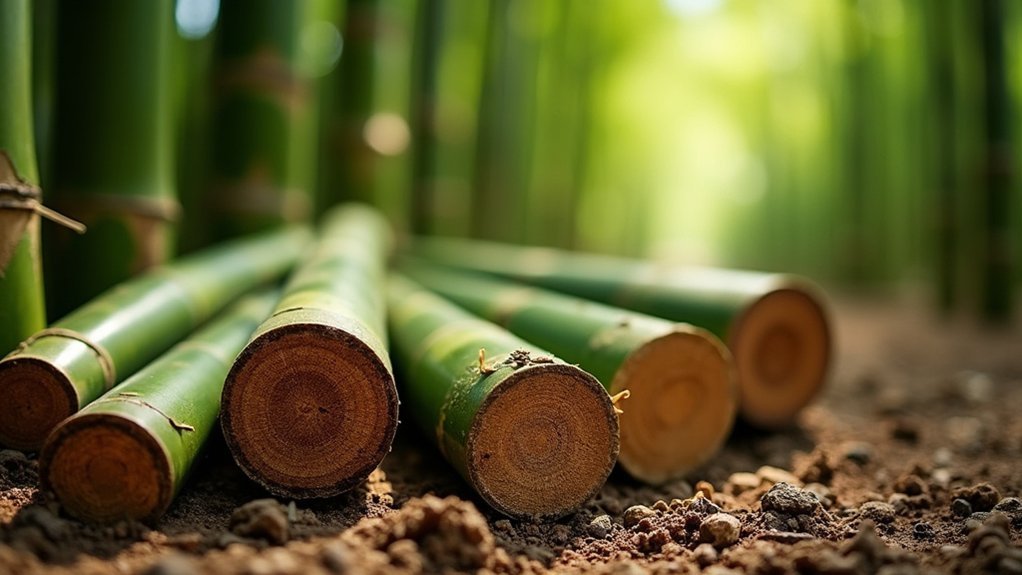
When creating a durable and attractive bamboo fence, selecting the right species is essential to your project’s success. Look for thicker, denser varieties like Moso bamboo, which offers exceptional strength due to its thick walls and high compressive resistance against wind and weather.
Consider your local availability to keep costs manageable, while prioritizing moisture-resistant species for outdoor applications. Natural variations in bamboo poles are expected, as they may differ in size, shape, and color while still providing excellent functionality. Thermally treated options like MOSO Bamboo X-treme provide enhanced stability and longevity in exposed conditions.
Source locally to save money, but prioritize moisture resistance for outdoor fencing. Thermally treated bamboo ensures lasting performance in the elements.
While fast-growing species offer sustainability benefits—absorbing more CO2 than hardwoods—they may require more frequent maintenance.
Balance environmental impact with practical concerns by choosing species that naturally resist pests, reducing the need for chemical treatments while delivering the aesthetic appeal you’re seeking.
Essential Tools and Materials for Bamboo Fence Construction
Building a sturdy bamboo fence requires having the right tools and materials on hand before you begin the installation process.
For structural support, you’ll need 4×4 treated lumber posts, 2×2 or 2×4 rails, bamboo rolls or poles, and concrete mix for anchoring posts 18-24 inches deep.
Essential fasteners include 14-16 gauge tie wire, 2-inch deck screws, and joist holders.
Your toolkit should contain a cordless drill with tapered bits, level, circular saw, pliers, and post hole digger.
Don’t forget protective gear like work gloves and safety goggles.
For finishing touches, gather waterproof sealant, sandpaper, trim boards, and stain or paint.
Consider anti-pest treatments for untreated bamboo to guarantee longevity.
Using clamps during installation will stabilize bamboo sections as you work.
Two sawhorses provide an ideal work station for cutting bamboo posts to the proper height of 64-66 inches.
Planning Your Bamboo Fence Layout and Design
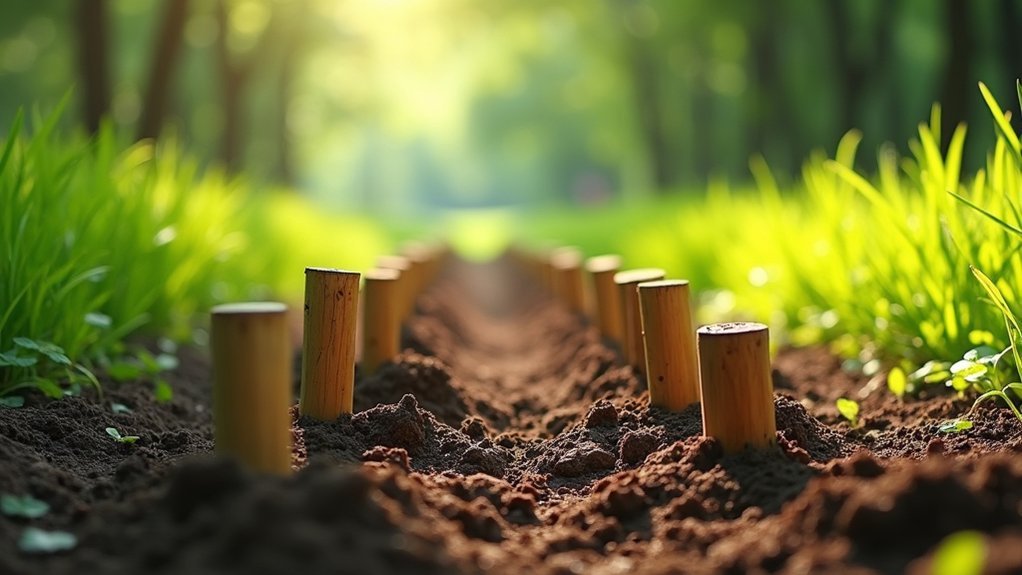
Before setting your first post, you’ll need to carefully map your fence’s boundary to guarantee it follows property lines while meeting your aesthetic and functional needs.
Choose between pure bamboo construction or a hybrid design with wood framing, considering how each option affects both appearance and durability in your climate.
Mark your post locations at 6-8 foot intervals, accounting for gates and corner posts that require additional reinforcement.
For optimal longevity, consider installing bamboo panels in a vertical arrangement that ensures structural integrity while maximizing privacy screening capabilities.
Strategic Fence Positioning
The success of your bamboo fence largely depends on thoughtful placement and design. Begin by determining your fence’s primary purpose—privacy, aesthetics, or security—as this will dictate its ideal position.
| Consideration | Action Step |
|---|---|
| Property Lines | Verify boundaries before installation |
| Sunlight Patterns | Position to minimize bamboo deterioration |
| Land Contours | Adjust design for slopes and elevation changes |
| Visual Impact | Confirm fence complements landscape flow |
| Obstacles | Identify underground utilities and natural barriers |
When positioning your fence, consider existing landscaping and the natural topography of your yard. Don’t overlook how your fence will affect light distribution throughout your garden. A poorly positioned bamboo fence can create unwanted shadows or block essential sunlight from reaching plants that need it. Remember that bamboo fences offer exceptional tensile strength comparable to steel while maintaining their environmental benefits.
Material Selection Essentials
Selecting the right materials for your bamboo fence underpins its long-term durability and structural integrity. Always choose pressure-treated lumber or galvanized steel posts to combat moisture and insect damage, particularly in humid regions where untreated wood quickly deteriorates.
For fasteners, opt for marine-grade stainless steel to prevent rust-induced weakening over time. It’s essential to match bamboo diameters with your post spacing—panels ¾” to 1″ thick work well for standard 6-8′ spans. Cedar posts are an excellent natural alternative due to their inherent termite resistance properties.
When purchasing bamboo, verify it has been treated with UV-resistant sealants to minimize sun damage. Your post material should correspond to your fence’s height and weight; 4×4 treated lumber (buried at least 2′ deep) suits most 6-8′ tall fences.
For heavier installations, increase post diameter proportionally to guarantee adequate support.
Aesthetics Versus Function
Balancing aesthetics with function stands as the cornerstone of successful bamboo fence design. Consider how your fence will serve dual purposes—creating privacy while enhancing your outdoor space’s visual appeal.
When planning your layout, integrate bamboo into your garden style, whether you’re aiming for tropical elegance or minimalist simplicity. You’ll need to decide between vertical or horizontal panel arrangements based on your privacy needs and design preferences. Creating a Bali-style home atmosphere requires thoughtful bamboo placement that complements existing landscaping elements.
Combining bamboo with other materials, like metal frames, can strengthen structural integrity without compromising its natural beauty.
Don’t forget to evaluate your space constraints and property terrain—bamboo’s adaptability makes it suitable for various layouts.
For enhanced visual impact, plan for climbing plants or strategic lighting that will showcase your bamboo fence, especially during evening hours.
Proper Ground Preparation Techniques for Stability
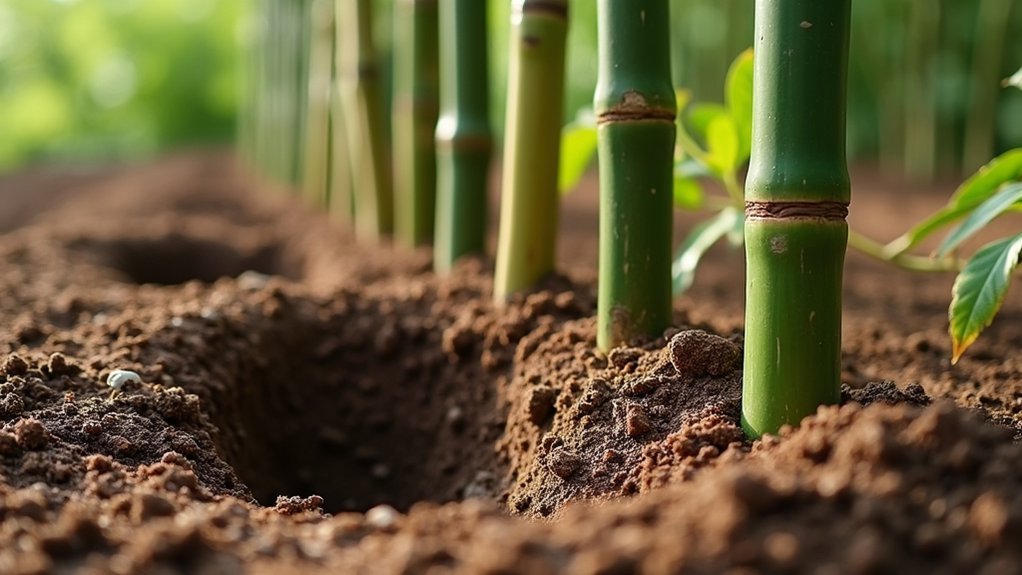
Before installing your bamboo fence posts, proper ground preparation creates the foundation for a stable, long-lasting structure. Clear the area of debris, rocks, and vegetation, then level the ground to prevent uneven pressure on posts. Use a string line to guarantee straight fence alignment.
Assess your soil type and improve drainage by adding gravel at the bottom of post holes. Consider using treated wood poles for maximum resistance against moisture and ground contact. In clay or unstable soil, incorporate crushed rock around posts for enhanced stability. Dig holes at least one foot deep with sufficient width for backfill material.
Create flat-bottomed holes and remove loose soil before setting posts. When backfilling, use a layered approach: gravel for drainage followed by compacted soil. Check vertical alignment frequently with a level.
Finally, mound soil slightly at the base to direct water away from posts.
The Art of Digging Post Holes for Bamboo Fencing
Proper hole digging forms the backbone of a successful bamboo fence installation. Your holes should reach at least 12 inches deep for standard installations, but consider 18-24 inches for windy areas.
Remember to position holes 4-6 feet apart for main supports, with triple-post configurations at corners and gates for added strength. Using a machete or chisel-like tool can help break through hard soil when digging your post holes.
For ideal results:
- Dig holes with diameter three times the post circumference, widening slightly at the base in cold climates to prevent frost heave.
- Add 2-3 inches of gravel at the bottom for improved drainage and moisture control.
- Make sure the lowest bamboo node sits above the soil line to prevent water pooling and rot.
Always verify vertical alignment using a bubble level in two perpendicular directions before securing with temporary bracing.
Treating Bamboo Posts for Extended Outdoor Durability
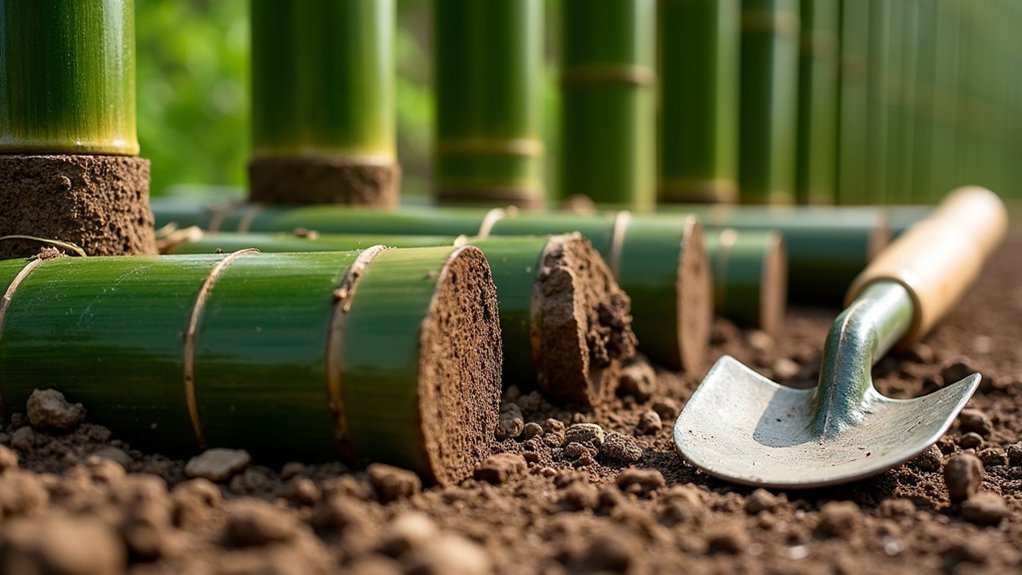
Bamboo posts require protective treatments to withstand years of outdoor exposure and prevent rot, insect damage, and structural failure.
You’ll need to choose between borax solutions, heat treatments, or pressure-treating methods based on your climate conditions and available resources.
For best results in high-moisture environments, combine chemical treatment with multiple layers of UV-resistant sealant, while drier climates may benefit from simpler saltwater soaking followed by oil-based protective coatings. Consider harvesting bamboo during the dry season to naturally reduce the initial moisture content, which will improve the effectiveness of any preservation method you select.
Protective Treatments Overview
To guarantee your bamboo fence posts survive the outdoor elements for years to come, treating them with appropriate protective solutions is essential. The natural sugars and starches in untreated bamboo attract insects and promote decay, but proper preservation extends lifespan from 1-2 years to 15+ years.
- Borax treatment – Submerge your posts in a solution of borax and boric acid for 2-7 days, creating a natural toxicity to insects and fungi while remaining environmentally friendly. The Vertical Soak Diffusion method is an effective alternative that uses the same preservatives but requires puncturing nodes for solution penetration.
- Surface sealing – Apply UV-resistant sealants after preservation to prevent sun damage and moisture penetration, focusing especially on vulnerable end grains.
- Ground contact protection – Coat the bottom 12 inches of posts with bitumen or asphalt and set them on gravel beds to prevent moisture wicking from soil contact.
Weather-Specific Application Techniques
When installing bamboo fence posts, your local weather conditions will ultimately determine which treatment and installation techniques you’ll need for maximum durability.
In humid environments, elevate posts off the ground and guarantee good ventilation to prevent moisture damage. Apply borax treatments more frequently and inspect regularly for fungal growth.
For sunny locations, use UV-resistant sealants and stains to prevent fading and degradation, reapplying them seasonally. Regular maintenance with specialized cleaners will help remove debris and preserve the outer layer of your bamboo fence posts.
In windy areas, anchor posts deeply and secure with stainless steel fixtures, guaranteeing tight weaving between panels.
Cold climates require additional support for snow loads and more frequent sealant applications. Monitor for frost damage during freeze-thaw cycles.
Whatever your climate, choose the appropriate bamboo species and maintain proper maintenance schedules to greatly extend your fence’s lifespan.
Setting and Securing Vertical Support Posts
The foundation of a sturdy bamboo fence begins with properly setting your vertical support posts. Select bamboo posts 2-4 inches in diameter, or opt for cedar if you need extra stability. Dig holes to approximately one-third the fence height and set posts in concrete for long-term durability.
The key to bamboo fence longevity lies in proper post installation—choose robust materials, dig deep, and set in concrete for lasting stability.
- Dig methodically – Create holes with clean, vertical sides that allow for 3-4 inches of concrete to surround each post, ensuring your bamboo stands straight against winter winds and summer storms. Adding a layer of pebbles for compaction at the base will provide additional stability and improve drainage.
- Position carefully – Place each post in its hole, checking for plumb with a level before pouring your concrete mixture.
- Secure thoroughly – Add steel or wooden stakes alongside posts in softer soils, then tamp the surrounding area firmly to prevent future settling.
Attaching Horizontal Bamboo Rails With Traditional Methods

You’ll find the traditional bamboo fence looks most authentic when you secure horizontal rails using twine lashing techniques rather than modern fasteners.
To create a proper lashing, wrap your natural twine in a figure-eight pattern between the rail and post, pulling tight with each pass until the connection feels solid. When installing the horizontal rails, ensure that both ends include bamboo nodes for optimal structural integrity and to prevent crushing at connection points.
For an alternative traditional method, you can drill matching holes through both pieces and insert bamboo pegs, which offer excellent strength while maintaining the fence’s natural aesthetic.
Twine Lashing Techniques
Traditional twine lashing techniques offer a timeless and elegant method for attaching horizontal bamboo rails to your fence posts without using modern fasteners.
Begin by positioning your horizontal rail just below a node on the upright post, then anchor your waxed lashing cord with a clove hitch knot. Wrap the twine around both poles in an X or H pattern, keeping tension consistent for a secure joint. The square lashing method provides exceptional durability when properly executed with multiple wraps.
- Start by measuring 4-5 feet of waxed cord per joint, which provides enough length to create multiple wraps while maintaining the rustic aesthetic.
- Create tight figure-eight patterns that distribute pressure evenly across the bamboo surfaces.
- Finish with two overhand knots, leaving a small tail that allows for future adjustment as the bamboo ages.
Bamboo Peg Connections
Connecting horizontal bamboo rails to fence posts using age-old pegging techniques creates joints that are both structurally sound and visually appealing.
Drill holes in your upright posts sized precisely to fit your horizontal rails snugly, then insert the rails until they contact the back wall for maximum stability.
Secure these connections by drilling through both pieces and inserting bamboo pegs. For through joints, allow rails to pass completely through the post before pegging. Confirm your peg diameter matches the hole exactly for a tight fit.
For angled connections, create tenon joints by positioning rails at angles and drilling holes that accommodate pegs just above and below knots.
Keep in mind that bamboo pegs have limited strength, supporting approximately seven kilograms per three square centimeters of surface area.
Start by fitting and pegging all joints before adding any lashings, which will enhance both strength and appearance.
Creating Decorative Bamboo Fence Patterns and Styles
Beyond basic installation, bamboo fencing presents countless creative opportunities for homeowners looking to enhance their outdoor spaces. You can transform your garden boundary from merely functional to visually striking by incorporating different bamboo types and arrangement techniques.
- Create depth and visual interest by mixing blonde and dark brown bamboo poles in herringbone or woven patterns, which provide both aesthetic appeal and structural strength.
- Add Asian-inspired designs by cutting poles to varying lengths and arranging them in geometric patterns with both horizontal and vertical alignments.
- Consider layering your bamboo fence with different thicknesses or incorporating painted elements using natural dyes for a personalized touch that complements your garden’s theme.
For indoor spaces, these same techniques work beautifully as room dividers or decorative wall features.
Weatherproofing Your Bamboo Fence for Longevity
While bamboo offers natural beauty to any landscape, its longevity depends entirely on proper weatherproofing techniques. Untreated bamboo may last only 2 years, but with diligent maintenance, you can extend this to 15-20 years.
| Treatment | Frequency | Lifespan Gain |
|---|---|---|
| Sealant Application | Every 2-3 years | 5-10 years |
| Anti-fungal Treatment | Annually | 3-5 years |
| Structural Inspection | Every 1-2 years | 2-3 years |
Start by elevating posts on concrete footings to prevent ground moisture absorption. Apply high-quality waterproof sealants designed specifically for bamboo, and reapply every 2-3 years. In humid or rainy climates, increase your maintenance schedule accordingly. Regular cleaning with mild soap will prevent mold growth, while sanding before resealing guarantees proper adhesion of protective coatings.
Seasonal Maintenance Tips for Bamboo Fence Posts
Although bamboo fences require minimal upkeep compared to other materials, seasonal maintenance guarantees their longevity and preserves their natural beauty.
Invest in seasonal bamboo fence care—minimal effort rewards you with lasting natural elegance.
Adapt your care routine to the changing seasons, focusing on specific needs during each climate shift.
- Spring Revival – Clean winter debris from your fence, inspect for cold weather damage, and apply a fresh coat of sealant before warm weather arrives to prevent drying and cracking.
- Summer Protection – Use a low-setting pressure washer for gentle cleaning, then apply two coats of quality sealant 24 hours apart to shield against intense UV rays and drying winds.
- Fall/Winter Preparation – Remove summer debris, apply protective coating against wet conditions, and regularly clear snow accumulation to prevent excessive weight and moisture damage.
Troubleshooting Common Bamboo Fence Post Issues
Despite their natural durability, bamboo fence posts will inevitably face challenges that require prompt attention and practical solutions.
When you notice posts leaning, immediately check anchoring depth and reinforce with deeper placement or additional support structures.
For rotting issues, remove affected sections and apply protective sealants to prevent spread. Raise posts slightly off the ground to reduce moisture contact.
If you spot cracks developing, apply bamboo-specific oils before they expand, and redistribute weight stress across the fence.
Address discoloration by applying UV-resistant finishes and scheduling regular maintenance with protective stains.
For loose connections, tighten fasteners and consider replacing metal components with stainless steel alternatives to prevent corrosion.
Inspect regularly for pest damage, treating immediately with natural repellents or specialized bamboo preservatives.
Frequently Asked Questions
How Does Bamboo Fencing Impact Local Wildlife and Ecosystems?
Bamboo fencing can both protect and harm wildlife. You’ll see it deterring animals from crops while potentially disrupting migration routes. It’s a double-edged sword that can fragment habitats but also create new microhabitats.
Can Bamboo Posts Be Safely Removed and Repurposed Later?
Yes, you can safely remove bamboo posts using tools like post pullers or hi-lift jacks. Once extracted, clean off soil or concrete residue, treat the bamboo with preservatives, and repurpose it for trellises or decorative elements.
Will Bamboo Fencing Affect My Property’s Resale Value?
Well-maintained bamboo fencing can boost your property’s resale value by enhancing curb appeal and attracting buyers who value privacy and aesthetics. You’ll see better ROI with professional installation and regular maintenance.
How Do Bamboo Fences Perform During Extreme Weather Events?
Bamboo fences perform exceptionally well during extreme weather. They’ll withstand hurricane-force winds, resist moisture damage during floods, and maintain stability through temperature fluctuations. Their lightweight yet sturdy nature makes them ideal for surviving storms.
Are There Neighborhood or HOA Restrictions for Bamboo Fencing?
Yes, your HOA may restrict bamboo fencing due to invasiveness concerns, aesthetic standards, or maintenance requirements. You’ll need to check your association’s bylaws and local ordinances before installation to avoid violations.
In Summary
By setting your bamboo fence posts properly, you’ve created a sustainable, attractive boundary that’ll last for years. Remember to choose the right species, prepare your ground thoroughly, and maintain your fence seasonally. Don’t forget to apply weatherproofing treatments regularly. When issues arise, address them promptly to prevent further damage. With these techniques, you’ll enjoy your beautiful bamboo fence for many seasons to come.

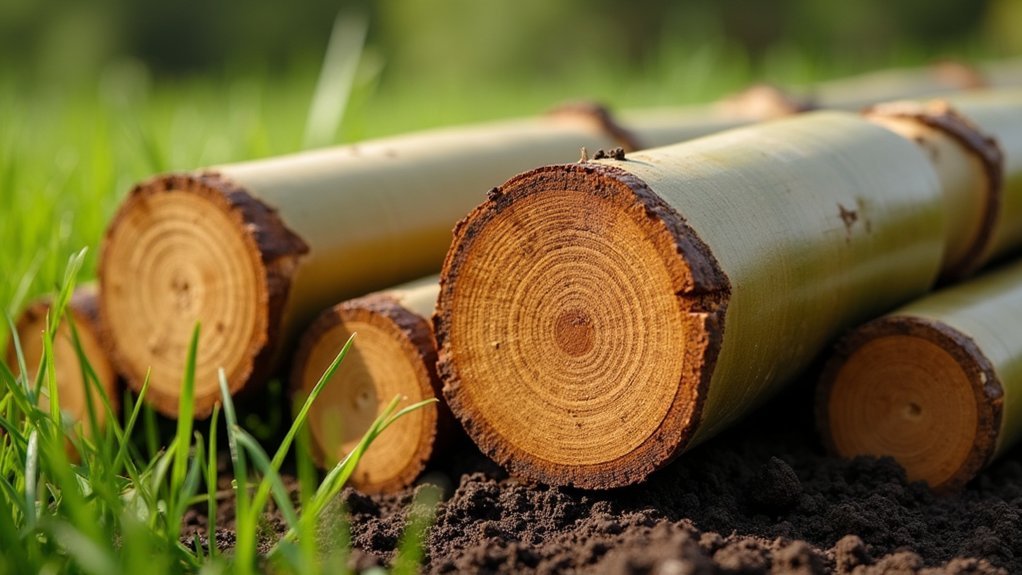



Leave a Reply